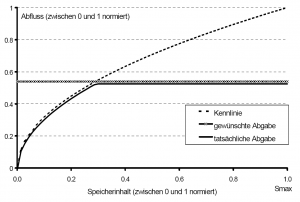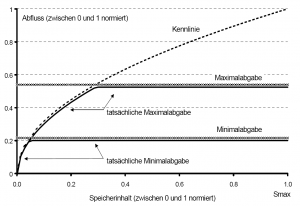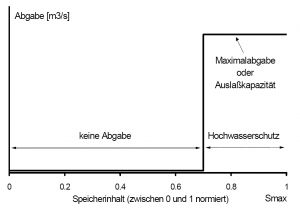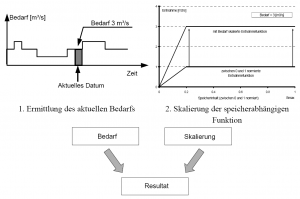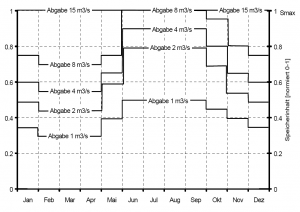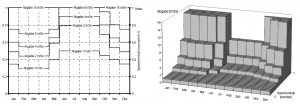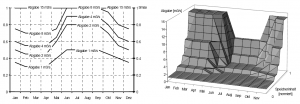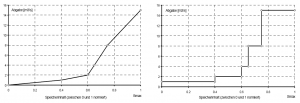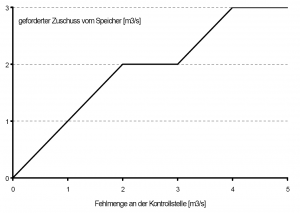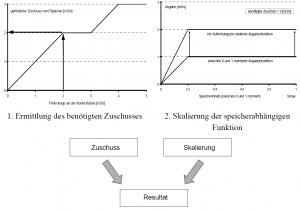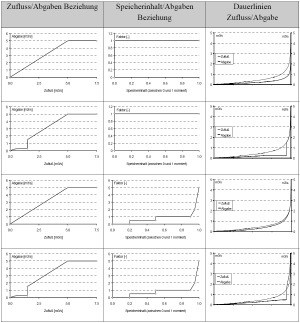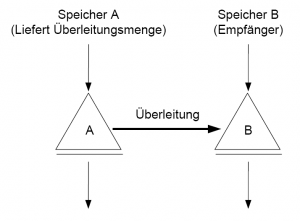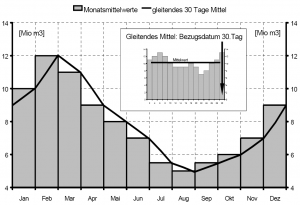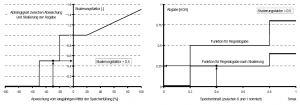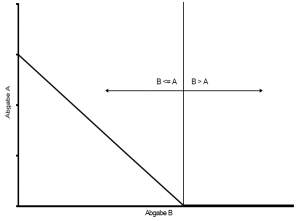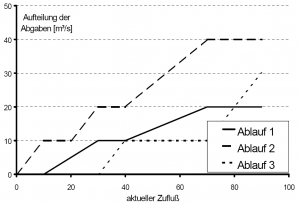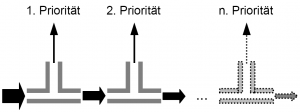Betriebsregeltypen/en: Unterschied zwischen den Versionen
Keine Bearbeitungszusammenfassung |
Keine Bearbeitungszusammenfassung |
||
| Zeile 17: | Zeile 17: | ||
*Mathematical abstraction: | *Mathematical abstraction: | ||
:All outlets obeying an operating rule are functions of the reservoir's storage volume and cannot exceed the maximum capacity of the outlets when fully open. As soon as the capacity of the outlets exceeds the required discharge, it can be adjusted by | :All outlets obeying an operating rule are functions of the reservoir's storage volume and cannot exceed the maximum capacity of the outlets when fully open. As soon as the capacity of the outlets exceeds the required discharge, it can be adjusted by partially closing the control elements. | ||
All forms of releases from storage facilities mentioned below are subject to this restriction. | All forms of releases from storage facilities mentioned below are subject to this restriction. | ||
Version vom 24. März 2021, 12:55 Uhr
The operating plan of a dam or a reservoir network is part of the official approval of plans and usually is available as a report or presentation. Its complexity can vary: it ranges from simply defining flood protection areas and setting a report and alarm plan to notify the supervisory authorities in exceptional situations to complex sets of rules concerning functional dependencies that derive discharges from varying system states.
As follows, principles to clarify the variety of possible regulations and reduce them to essential dependencies are presented. A concept is derived to represent most operating rules by a few basic calculation rules. The given selection does not claim to be complete, but it is likely to contain the rules applied in practice.
Principle: Verification of Physical Limits
When specifying discharges according to an operating rule, it is assumed that the outlet capacity is sufficient to meet these discharges. Thus, dimensioning the outlet element must consider the operating requirements. In principle, the physically possible discharge, given by the characteristic curve of the outlets at full opening, is fixed as the upper limit value.
If the pressure level or the outlet capacity when fully opened is sufficient to discharge the desired quantity, the discharge can be throttled to the intended level by closing a slide. If the pressure level is insufficient, only the hydraulically possible discharge can be discharged.
- Mathematical abstraction:
- All outlets obeying an operating rule are functions of the reservoir's storage volume and cannot exceed the maximum capacity of the outlets when fully open. As soon as the capacity of the outlets exceeds the required discharge, it can be adjusted by partially closing the control elements.
All forms of releases from storage facilities mentioned below are subject to this restriction.
Rule type 1: Definition of a minimum output or a maximum output that can be discharged without damage in the underflow.
- Dependence:
- The specification of a minimum or maximum charge is based on requirements in the underflow of a reservoir. The maximum discharge is often based on the discharge of a critical, lower lying water cross section. Consequently, a clear hydraulic method exists for its determination. In contrast, there is no clear guideline for the minimum discharge. Often certain ratios of MNQ or MQ are used. Independent of the determination of the minimum or maximum discharge. However, the dependence on the capacity of the discharge elements, described above as a principle, is applied. Minimum and maximum discharge can only be discharged if the capacity of the outlets is sufficient at the given pressure head. Since it is unlikely to happen in practice that the dimensioning of the outlet elements and the required discharge are contradictory, the reference to the dependence on the storage capacity content is rather theoretical, but necessary for the derivation of general laws.
- Mathematical abstraction:
- Minimum and maximum discharge are functions of the reservoirs contents and follow the characteristic curve of fully opened outlets at very low filling. As soon as the capacity of the outlet organs is sufficient for the required delivery quantity, the delivery can be kept constant by partial closing of the control elements.
Rule type 2: Maintaining a flood protection area, perhaps variable in time over the year
- Dependence:
- The definition of a flood protection area includes as a minimum requirement only the naming of a volume, which has to be kept free for the storage of flood water. The dimensioning is done based on flood fills with certain recurrence intervals. If the water level exceeds the mark of the protection area, an increased discharge to the lower course of the reservoir ensures that the area is kept free. Thus, this regulation is reduced to a relation between discharge and reservoir content, whereby the outlet capacity or a defined maximum discharge can serve as an upper limit for keeping it free. If the flood protection area is variable in time over the year, only the reservoir content changes from which the discharge is increased.
- Mathematical abstraction:
- Here there is a direct relation between storage capacity and release. If the storage capacity exceeds the mark of the flood protection area, a discharge occurs. If it remains below the mark, the discharge is set to zero.
Rule type 3: Direct drinking or service water withdrawal from a reservoir
- Dependence:
- Primarily the current demand determines the withdrawal from the reservoir, although it is generally subject to temporal variations. The demand is often limited upwards by water rights or maximum withdrawal quantities, which refer to selected time horizons such as day, month, quarter, year or others. If one initially only considers the current demand, this is determined by the requirements of a water supplier and defines the demand on the storage facility. There is no reference to the content of the reservoir. However, whether the demand can actually be met depends on the current content of the reservoir. This connection is either given by the constructional structure of the withdrawal facility or for reasons of foresighted management. For example, if particularly low reservoir fillings are reached, it is advisable to throttle withdrawals in good time to avoid the reservoir running empty and thus complete failure during prolonged periods of low water [1]. For this reason, there is usually a reserve space in every dam that is mainly used for drinking water supply, and special operating plans usually decide on its use.
- Mathematical abstraction:
- If the demand is exactly known and unchangeable, a direct relation between withdrawal and storage content can be defined. Normally, however, the demand is subject to certain variations. For this reason it is recommended to normalize the relationship withdrawal/storage content, where the current demand serves as scaling factor. If the storage content falls below a defined limit value, only a certain percentage of the current demand is satisfied. The limit value as well as the form of the function can be variable in time.
Rule type 4: Rule discharge to underflow
- Dependence:
- The control discharge into the underflow provides a discharge compensation with respect to seasonal differences of the inflow. If a minimum discharge is required, it will be included in the regular discharge. A Lamellenplan is often used to describe the regular discharge. This divides the storage capacity into different areas (pool-based operation) and assigns a discharge to each pool-based operation. When determining the pool-based operating plan, the long-term discharge and other withdrawals from the storage for other purposes play a decisive role. A reservoir should collect water in periods of high inflow but still not overflow in order to have sufficient reserves in periods of low inflow. The coupling of the releases to the storage pool-based operation is a clear function of the storage content. Since the system is supposed to react to variations in inflow during the year, the relationship between content and delivery is usually variable over time.
- Mathematical abstraction:
- As in the previous rules it is true that the output depends on the storage content. Usually, a pool-based operating plan is displayed in a two-dimensional diagram. The X-axis shows the time of one year, the Y-axis the storage capacity. Pool-based operations are drawn in the diagram as lines of equal outputs.
- Such a view is practical but not yet complete, as can be shown below. A three-dimensional representation of a simple pool-based operating plan makes this clear. On the X-axis is the time, on the Y-axis the storage capacity is plotted, while the Z-axis shows the output directed upwards.
- The 3D image viewed vertically from above again gives the two-dimensional shape. Instead of taking constant blocks for the individual time horizons, the case of a linear connection often occurs.
- For the individual time periods - here months - different functional dependencies between storage capacity and outflow are considered. If we also consider the storage contents/discharge relation for a selected point in time, there are two possibilities to connect the nodes of the discharge. On the one hand, there is the possibility of a linear interpolation, on the other hand, however, steps are also possible.
- In two-dimensional space this information is not visible and must be specified separately. However, there is usually the convention to assume that the output between two nodes is constant, i.e. to interpret the slat plan as shown above in the form of stair steps.
Rule type 5: Compliance with defined discharges in the underflow of reservoirs (low water increase / demand coverage)
- Dependence:
- In this case the current output is determined by requests from the underflow of a reservoir. A defined discharge should not fall below a defined flow rate at a cross section of a watercourse in the water resources system, which is called control point in the following and which is influenced by reservoir discharges. The outflow at the control point is composed of the discharge from reservoirs and the lateral inflows lying in between. If the current outflow remains below the setpoint, an additional flow from above lying storage tanks is necessary. The amount of the allowance depends on the difference between the target flow and the actual flow. Whether the required allowance can be fully provided from the storage unit depends on the current storage unit content, because the lower the filling is, the less favorable it is to have to provide additional water. In this context, the low water increase/demand behaves completely identical to drinking or raw water withdrawal, only the triggering factor differs. As mentioned before, a storage-dependent function is scaled by a factor, but this factor is now derived from a comparison between set values and current discharges.
- Mathematical abstraction:
- The determination of the discharge to increase low water levels or to cover the demand at control points is composed of several factors. On the one hand, a shortfall in quantity varying in size results from falling below a required target discharge. How this shortfall quantity is to act as a scaling factor on a storage release can be defined by a functional relation. The shortage functions as an independent quantity, the scaling factor as a dependent quantity.
- On the other hand, it is a question of the current reservoir filling, if and how the required allowance from the external contribution can be met. As before, a normalized memory dependent function together with the requested demand leads to a clear determination of the external contribution quantity. In the following |Fig. 10 a complete coverage of the increase target or the demand can only be achieved if the storage capacity is above a critical limit of about 25% filling level.
- If more than one storage facility has an influence on the relevant control point or if, in principle, more than one storage facility is to be used to meet demand, the required external contribution is to be divided among the storage facilities in accordance with a corresponding regulation. A distinction must be made between direct and indirect influence of a storage facility on the control point. A direct influence is always present when the storage release can have a direct effect on the flow condition at the control point, i.e. between storage and control point the natural flow behaviour can no longer be changed by regulating interventions. If this is not the case, an indirect influence is given.
- All reservoirs with a direct influence on the control point receive a missing quantity/factor and a content-dependent scalable function according to Figure 10. Thus, depending on the missing quantity and storage capacity, the actual delivery can be determined for each storage separately.
Rule type 6: delivery depending on the current reservoir external contribution
- Dependence:
- Here there is a direct coupling between the output and the current inflow to the reservoir. Similar to the pool-based operating plan, it is also an adaptation to different inflow situations. This is done to prevent depletion or overflowing or to obtain a variable discharge regime in the underflow. However, long-term inflow fluctuations are difficult to detect with this operating rule, since only momentary observations are made.
- For the final determination of an inflow-dependent discharge several components have to be considered. First of all, a relaiton between current inflow and discharge must be available. In addition to the current inflow, the current storage content plays an important role, because the relationship inflow/outflow does not have to be valid for the whole storage content. Thus it is very likely that this relation is completely abandoned or at least the release quantities are reduced if the storage level falls below a critical level.
- Because this rule can lead to the collision of relatively small storage fillings with a simultaneous high inflow - and thus a required high output - special attention must be paid to the principle of checking physical limits.
- Mathematical abstraction:
- In this case three functional dependencies play a role. First, there is a direct function between the current inflow and the outflow. The form of the function can be arbitrary. It is conceivable to reproduce only single areas of the inflow, which corresponds to a partial approximation of the discharge to the duration line of the inflow.
- On the other hand, the inflow/outflow function can be overlaid by a relationship between reservoir capacity and flow. For reasons of clarity it is recommended to work with a normalized function. This makes it possible to influence the result of the inflow/outflow function along the entire reservoir capacity, which is especially desirable for low storage fillings.
- Finally, the required discharge has to be checked with regard to the capacity of the discharge units.
- Below are examples of how the interaction of different functions affects the releases. The results are compared in the following figures in the form of inflow and outflow duration lines.
- In case of a linear relation between inflow and outflow and a constant factor over the storage capacity, the duration line of the outflow is a curve corresponding to the inflow but reduced by a certain percentage. If the factor/storage capacity relationship remains constant, the duration line can be changed by varying the inflow/outflow relationship. An additional modification of the factor via the reservoir capacity has the advantage of being able to respond to certain filling states in order to prevent an emptiying or overflowing of the reservoir.
Rule type 7: Influence of releases on a a system state
- Dependence:
- Rule 7 is a continuation and generalization of the low water elevation as described in rule 5. Rule 6 also falls under this heading. Just as a discharge deficit at a watercourse cross-section or the reservoir inflow can influence a discharge, any other system conditions can also influence the possible discharge. In general terms, this means that a discharge from a reservoir is triggered, increased or reduced due to a certain system state. Basically it is irrelevant where the system state occurs. In principle, all measurable variables that influence the transport and storage of water can be considered as system states, e.g. fillings of other reservoirs, discharges, runoff at a watercourse cross-section, a snow depth in the catchment area, current precipitation, current soil moisture, etc.
- Prerequisite for the application of such dependencies is the detection of the system state. Practically, this means that a measuring device must be available to determine the quantity or the required value is calculated using a mathematical model. Only momentary quantities are considered.
- If several system states shall influence the output, a superposition of the state variables is necessary according to a corresponding regulation.
- Mathematical abstraction:
- Mathematically the influence of system states on the output can always be solved by scaling. Two functions are necessary for this. The first function describes the relationship between reservoir capacity and output. The second one controls the dependence between system state and a scaling factor. The connection is done by multiplying the delivery with the scaling factor.
- A simple example is given by a transition from reservoir A to reservoir B.
- The decisive release is the transition from A to B. The system state under consideration is the reservoir capacity of B. It seems immediately obvious that a water delivery from A to B is only useful if reservoir A has sufficient reserves and reservoir B has sufficient capacity to hold additional water. This results in the following simple functions:
- Memory B takes 100% of the output of A as long as its filling does not reach 70% of the maximum content. Furthermore, it is undesirable to receive additional water for flood protection reasons. The scaling factor decreases from 70% filling to zero. Storage tank A can transfer water to B with an increasing tendency from a filling level above 50%. The actual transfer, however, only results from the interaction of both functions, taking into account the current tank filling of B and the scaling derived from it.
- For memory A the definition of the output is in m³/s, while the function at memory B receives the unitless scaling factor. In principle, however, it is just as conceivable to exchange the meaning of the functions and to use a unitless function for memory A to scale the desired transfer quantity at memory B.
Rule type 8: Influence of a release by balances
Dependency:
- This rule is an extension of rule no. 7. Instead of using a current state variable, the balance of a system state is linked to an output. It is important that there is a clear time period for the formation of the balance sheet, whereby it is irrelevant whether the balance is interpreted as a sum or as an average. A function that displays scaling factors depending on the actual balance can be used to influence charges.
- In practice, this form of dependency is often found where water rights define maximum withdrawal quantities per time unit. But the application of a balance is also interesting in connection with the long-term behaviour of reservoir fillings or inflows. For example, a discharge could be reduced in order to build up reserves if the inflow of the past winter half year was below a defined expected value. Another application is the comparison between long-term and current moving averages of reservoir filling. If the current values deviate from the long-term values by a certain amount, the discharge can be reduced or increased to compensate.
- If several links between a delivery and different balance sheets are desired, it is possible to overlay several balance sheets (see example at the end of this chapter).
- Mathematical abstraction: Datei:Theory Abb16.pngFigure 16: Example of a rule output regulation
- The influence of the balance sheet on the discharge is formed by two functions according to rule 7. In addition to the already necessary reservoir capacity/discharge function there is a relation between balance and scaling factor. The scaling factor is taken from the difference between actual balance and expected value.
- The method is demonstrated with a simple example of a rule submission.
- For a reservoir A, long-term monthly mean values of the content and derived sliding 30-day mean values of the storage filling as well as the rule for the regular discharge are known.
- If, for example, on May 1st the average value of the storage capacity calculated from the last 30 days would amount to 5.6 million m³ and thus, according to Fig. 15, deviates by 30% from the long-term average value of 8 million m³, a scaling factor of 0.5 follows (see Fig. 16). With this value the control output is reduced and delivers only 0.25m³/s at a current memory filling of 40%, i.e. 50% less than intended.
- The relationship between balance deviation and scaling factor indicates that only from a difference greater than 20% a change of the control output takes place. In case of a downward deviation of more than 20%, the control output is reduced stepwise. If the actual moving 30-day average exceeds the long-term values by more than 20%, the standard output is increased continuously.
- Basically there is also the possibility of the extension by overlaying and combining several water balances.
- The interaction between water balance and tax function is explained below.
Rule type 9: Priorities in case of several, competing releases from one reservoir
- Dependency: Datei:Theory Abb18.pngFigure 18: Example for assigning priorities via the location of functions
- If there are several releases from a reservoir, the situation can occur that not all releases (uses) can be fulfilled to 100%. In such cases, priorities have to be specified, which determine an order of the first deliveries to be satisfied. The specification of priorities is often a consequence of political decisions and is not subject to physical conditions.
- On the other hand there are priorities which are based on physical values. An example in this sense is the turning off of a turbine in times of water shortage in favour of a secured water supply. In practice, operating rules often meet this problem by fulfilling a use up to defined storage contents, but not maintaining it below that.
- Another way to describe priorities is to reduce a value A exactly by the amount, which is done by a second value B, where the value A cannot become smaller than zero.
- Practical example:
- This example can be shown by means of the practical operating conditions at the Wiehl dam. The Wiehl dam serves primarily for drinking water supply and flood protection, secondarily for energy production. In addition a minimum flow of 100 l/s has to be guaranteed in the lower course of the Wiehl dam. The first priority is the drinking water supply. In order to ensure a sufficient water quality in the reservoir, additional charges used for energy production are stopped when the reservoir content falls below about 70% of the total content. As both the minimum charge and the turbine charge are discharged into the Wiehl, it would also be superfluous to maintain the minimum charge if water is simultaneously discharged through the turbine. This results in a case of a reduction of a discharge A (minimum levy) by the amount of levy B (turbine) as described above[2].
- Mathematical abstraction:
- Assuming that for each use, as described under the above rules, a functional dependency between storage content and output exists, a ranking of several uses is already given by the location of the function's nodes. Decisive is the respective reservoir capacity from which the setpoint of the desired output is no longer covered to 100% or even reduced to zero.
- In the example shown, the ranking of the uses is clearly visible. First the turbine is switched off, then the low water elevation until only the delivery for the water supply remains.
- In addition, it is possible to directly compare two or more charges. Such a rule could be:
- If output B > 0 and the reservoir capacity S < X, then reduce output A by the amount of output B, whereby output A may not become less than zero.
- This means that a linear dependency exists between A and B until B is equal to the value of A. If B increases further, A remains constantly zero.
Rule type 11: Water distribution
- Dependence:
- If there is a need to distribute water within a water resources system, a distribution rule must be defined.
- Two types of diversions can occur:
- Diversion that exclusively follow hydraulic laws
- Adjustable diversions
- In both cases, relations can always be defined as a function of the inflow. In the second case, these distribution rules represent an operating rule, since they directly influence the transport and storage behavior of water. The number of outgoing drains is basically not limited. The difference to distributions at dams is that in this case no storage content can be used as reference value.
- Practical example:
- The water supply of Windhoek, the capital of Namibia, is provided by three dams. However, the withdrawal for drinking water supply is only possible from one dam - Von Bach Dam. The remaining two reservoirs are connected to the main dam by pipes. However, the transfer volume between Swakopport Dam and Von Bach Dam is not exclusively available for refilling the Von Bach Dam, but also serves to supply the town of Karibib with drinking water.
- Mathematical abstraction:
- For the definition of division rules, functions depending on the current inflow are the appropriate representation. Thus, both a hydraulic description and a description serving the management of the reservoir are possible. For each outflow leaving the branching structure a distribution function has to be specified. If the functions are to be variable, a scaling is recommended.Datei:Theory Abb21.pngFig. 21: Example of a threshold concept for a division into two flows
- If the allocation functions cannot be pre-defined, but the quantities to be derived only later result from demand calculations, then a threshold value concept is suitable, which in turn can work with scaling factors. The threshold value is scaled by a factor and is therefore variable. As long as the inflow is lower than the threshold value, the entire inflow is used to satisfy the demand. Only when the current inflow exceeds the threshold value, the remaining amount is discounted.
- If a division into more than two sequences is necessary, the threshold value concept can be applied several times in succession. The sequence determines the priorities of the water allocation.
Literature references
- ↑ Schultz, G.A. (1989): Entwicklung von Betriebsregeln für die Wupper-Talsperre in Niedrig- und Hochwasserzeiten. Wasserwirtschaft 79 (7/8) S. 340-343
- ↑ Aggerverband (1999): Hydrological Safety of the Genkel and Aggertal Dams. Expert opinion of the Department of Engineering Hydrology and Water Management, TU Darmstadt
